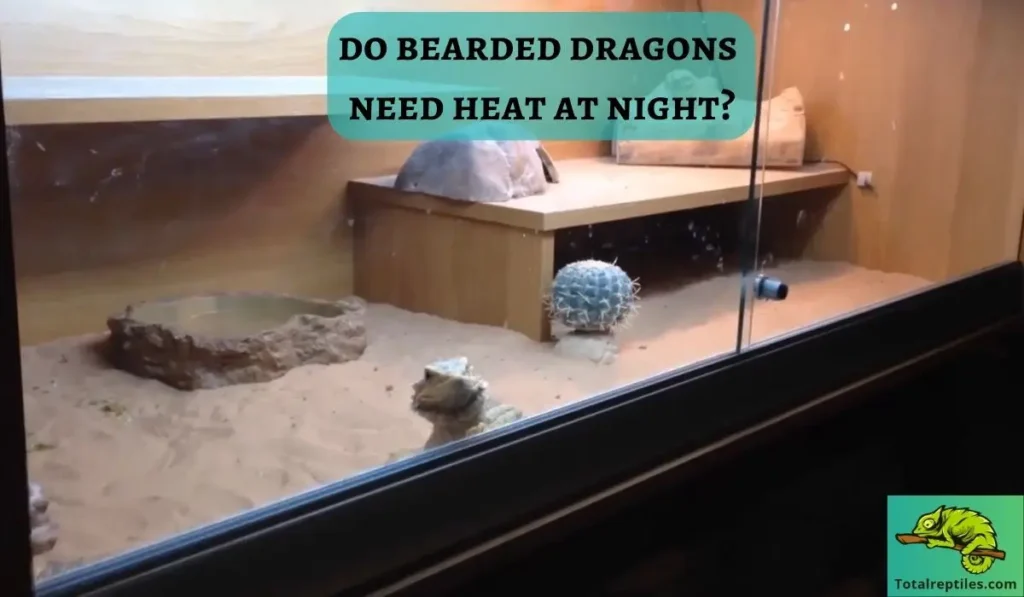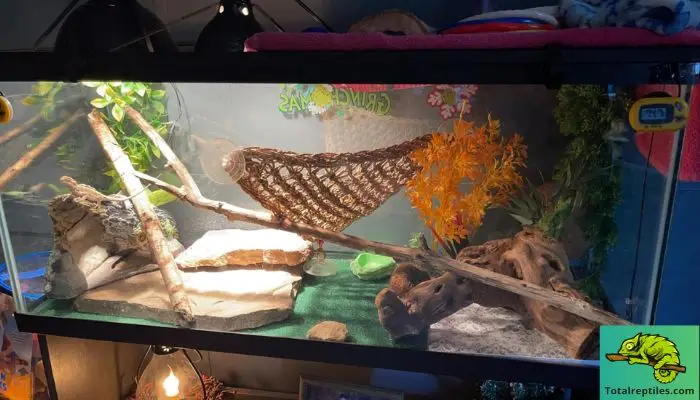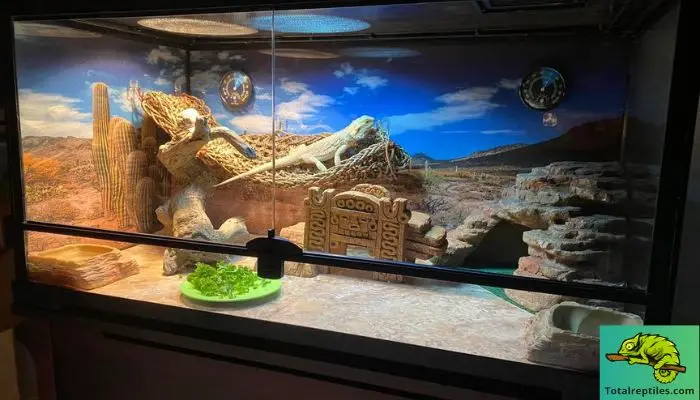For many new bearded dragon owners, whether or not to provide heat at night can be very confusing. After all, these reptiles are cold-blooded and require external heat sources to maintain body temperature. So, do bearded dragons need heat at night?
Bearded dragons do not normally require external heat during the night. But in certain situations with below 15°C or 59°F temperatures, these reptiles will require some supplementary heating throughout the night.
Now, how much heat will bearded dragons need when the temperature is below 15°C or 59°F? Also, is the case the same for baby bearded dragons? Stick to the end of this discussion to know everything regarding the topic.

Do Bearded Dragons Need Heat at Night?
As mentioned earlier, bearded dragons are not warm-blooded animals. To thermoregulate, they need stable temperatures. However, even in natural settings, the environment that they live in does not offer stable temperatures all the time.
For that reason, these reptiles often take the help of different heat sources. During the day, they will require a hot spot as hot as 110°F or 43°C. Along with that, they need a cooling site that is in the low 80°F or 26°C.
But what about at night? Do bearded dragons need a heat lamp at night? Generally, bearded dragons typically do not seek out heat sources as long as the temperature is above 65°F 18°C.
However, when it gets lower than 15°C or 59°F, these reptiles will require a heating source. That is, you should use a heating lamp or any other heating source inside the lamp when the temperature is below 59°F.
They can eventually get ill if you do not provide enough heat and let them be too cold. In fact, the situation could be quite fatal if there’s no heat source around when the temperature is shallow.
How to Keep Bearded Dragon Warm at Night?
You have a lot of options when it comes to keeping the bearded dragons warm at night. To give you a fair idea about them, here’s a description of each:

Ceramic Heat Emitters
One of the most popular options among bearded dragon pet owners is ceramic heat emitters. As the name suggests, these give off heat when you turn them on. But the good part is that the heat is in the infrared form.
In other words, the ceramic heat emitters will not produce any light. That alone makes it a great alternative to red light bulbs. Moreover, ceramic heat emitters are inexpensive and can last for a prolonged time.
Infrared Bulbs
The infrared bulbs, otherwise known as nighttime bulbs for bearded dragons, have one big difference from the regular bulbs. That is, they have a much lower rating than the standard light bulbs.
That means that infrared bulbs are generally more power-efficient than standard bulbs. Nonetheless, the main part is that the bulbs can deliver a good amount of heat without giving off too bright of a light.
Typically, you will find these offering a soft and dim purplish glow. For that reason, there will be no need to worry about the light disrupting the natural sleeping pattern of bearded dragons.
Heating Mats
As the name suggests, these are nothing but flat pads that can provide heat. These mats stick to the side, bottom, or top of the tank. And after placing them, they will bring extra heat from outside the enclosure.
But, you need to note down one important thing. You should avoid heating mats if you have wood inside the bearded dragon tank. These mats can cause a fire when you keep them close to flammable material.
So, opt for the heating mats only when you have a glass bearded dragon enclosure. Even so, you should monitor the heat of the pads. Make sure that they do not get too hot. Otherwise, they can crack the glass.
Heating Cables
If you do not want to go through the hassle of placing bulbs or mats inside the tank, the heating cables are great. They are flexible and easy to install. With insulation on the exterior, these cables can emit heat when you plug them in.
You can create tight coils or large loops inside the enclosure, letting you disperse the heat accordingly. It is even possible to attach the wires to the outside of the tank. Through that, you can ensure that no accidents take place when they are on.
You do not need to worry too much about the heating cables. They are generally water-resistant and have a good overall build quality. So, even with a high-humidity enclosure, there’s nothing to worry about.
Heat Rocks
Do you not want to ruin your natural ambiance in the enclosure? You don’t have to! Heat rocks are an excellent natural-looking heating source that blends exceptionally well inside the bearded dragon enclosures.
However, it is better not to pick the heating rocks that are not adjustable. The bearded dragons can sit on the rock for a prolonged time without realizing how hot the surface is, causing skin burns.
Heating Lamps
To be exact, you can consider infrared bulbs as heating lamps. However, there are other types of heat lamps available for lizards. But the problem with those is that they emit light, which, as you know, can disrupt the sleep of bearded dragons.
Therefore, it is better to consider other options before ending up with a heating lamp for your bearded dragon tank.
When to Turn Off Heat Lamp for Bearded Dragon?
You should generally turn the heating lamp off during the night. They require a temperature drop to regulate the circadian rhythm and fall asleep. Now, even though bearded dragons do not need heat during the night, too low a temperature is not good.
As discussed earlier, you must turn the heating lamp on when the temperature is below 15°C or 59°F. On the other hand, when the temperature is well above 65°F or 18°C, turn the heating lamp off.
Remember to monitor the temperature inside the closure continuously. Too much heat will make the bodies of the bearded dragons overheat, which can eventually lead to death.
On the other hand, too low temperatures cause hypothermia in reptiles, hindering them from staying active. Hypothermia can even slow down their digestion and make their immune system malfunction.
READ MORE: How Long Can A Bearded Dragon Go Without Heat?
What Wattage Heat Lamp for Bearded Dragon 40 Gallon Tank?

For a 40-gallon tank, you should use at least a 100-watt heating bulb. However, you should check whether the basking spot and the rest of the spot have the right temperature reading after installing the bulb.
The basking spot should be around 95°F or 35°C. And the rest of the tank needs to be between 75°F to 80°F or 23.8°C to 26.67°C. If you notice that a single 100-watt heating lamp is failing to keep the tank heated up, pair it with an infrared bulb.
But what should be the wattage? If you pair it up with a 100-watt heating bulb, you should get a 60-watt infrared bulb. In such cases, make sure that you are not overheating the tank. Always monitor the temperature inside.
Do Baby Bearded Dragons Need Heat at Night?
If the enclosure’s temperature is below 65°F 18.33°C, baby bearded dragons will require external heat at night. In the wild, bearded dragons will find a spot around 70°F to 75°F during the nighttime.
That temperature range allows the reptiles to get a proper night of sleep. But in an enclosed environment, bearded dragons have little choice in selecting the spot to sleep.
Therefore, you should always keep a close eye on the temperature gauge. When you see that the temperature is going below 65°F, turn the external heating device on. And once it reaches 70°F, turn it off again.
Final Words
Still confused regarding do bearded dragons need heat at night? In short, they do not need external heat unless the temperature of their tank is below 15°C or 59°F. If the temperature goes below that, you should turn on a heating source.
Now, when it comes to installing a heating source, ceramic heat emitters and infrared bulbs are generally good picks. They work like a charm and do not associate with any side effects. So, you should put them on the top of the list.

